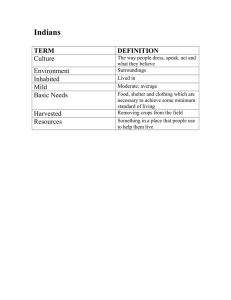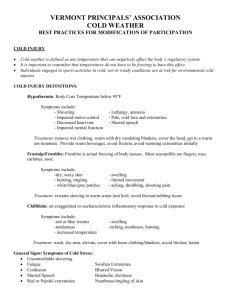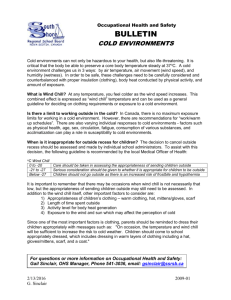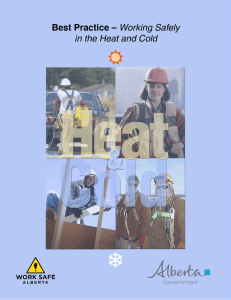WORKING IN TEMPERATURE EXTREMES 1. HEAT Introduction
advertisement
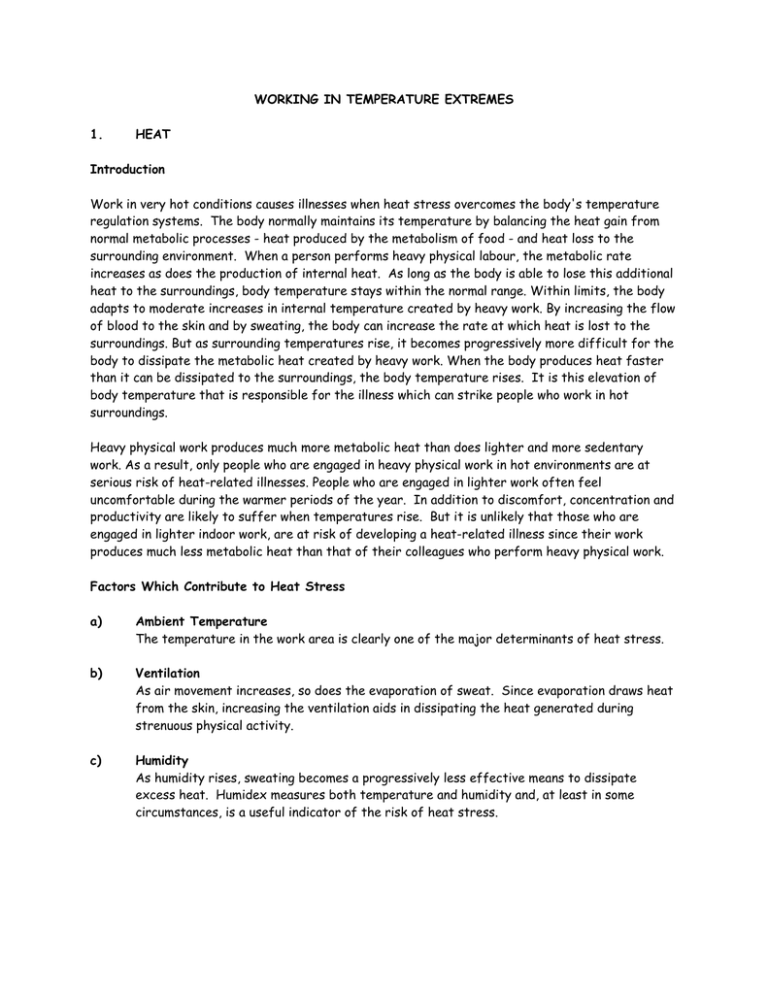
WORKING IN TEMPERATURE EXTREMES 1. HEAT Introduction Work in very hot conditions causes illnesses when heat stress overcomes the body's temperature regulation systems. The body normally maintains its temperature by balancing the heat gain from normal metabolic processes - heat produced by the metabolism of food - and heat loss to the surrounding environment. When a person performs heavy physical labour, the metabolic rate increases as does the production of internal heat. As long as the body is able to lose this additional heat to the surroundings, body temperature stays within the normal range. Within limits, the body adapts to moderate increases in internal temperature created by heavy work. By increasing the flow of blood to the skin and by sweating, the body can increase the rate at which heat is lost to the surroundings. But as surrounding temperatures rise, it becomes progressively more difficult for the body to dissipate the metabolic heat created by heavy work. When the body produces heat faster than it can be dissipated to the surroundings, the body temperature rises. It is this elevation of body temperature that is responsible for the illness which can strike people who work in hot surroundings. Heavy physical work produces much more metabolic heat than does lighter and more sedentary work. As a result, only people who are engaged in heavy physical work in hot environments are at serious risk of heat-related illnesses. People who are engaged in lighter work often feel uncomfortable during the warmer periods of the year. In addition to discomfort, concentration and productivity are likely to suffer when temperatures rise. But it is unlikely that those who are engaged in lighter indoor work, are at risk of developing a heat-related illness since their work produces much less metabolic heat than that of their colleagues who perform heavy physical work. Factors Which Contribute to Heat Stress a) Ambient Temperature The temperature in the work area is clearly one of the major determinants of heat stress. b) Ventilation As air movement increases, so does the evaporation of sweat. Since evaporation draws heat from the skin, increasing the ventilation aids in dissipating the heat generated during strenuous physical activity. c) Humidity As humidity rises, sweating becomes a progressively less effective means to dissipate excess heat. Humidex measures both temperature and humidity and, at least in some circumstances, is a useful indicator of the risk of heat stress. d) Clothing Clothing can interfere with sweating and heat dissipation. People working in warm environments normally dress lightly. However, some tasks require the worker to wear heavy or tightly fitting clothing, or protective equipment, which can reduce heat dissipation and increase heat stress. e) Radiant Heat Radiant heat sources contribute to the heat load, but the impact of radiant heat sources are not fully accounted for by normal measurement of workplace temperature. The additional heat load that radiant sources generate, needs to be taken into account when people work around furnaces, other radiant sources of heat or indirect sunlight. f) Exertion Rate Heavy physical work generates heat at rates from 5 to 10 times those produced by lighter work loads. Attempts to prevent occupational heat related illnesses typically focus on physically demanding work such as digging and carrying heavy loads. g) Acclimatization Within reasonable limits, people are able to adapt to work in hot environments. Over as short a period as a few days, people can develop a tolerance for quite hot work environments. Heat Illness Serious heat-related illnesses invariably involve people engaged in strenuous activity in very hot environments. Most people will occasionally find a Nova Scotia summer day uncomfortably hot. But, unless they are involved in very strenuous activities, they are very unlikely to be at risk of developing any serious-heat related illness. Among the illnesses produced by excessive heat stress are heat rash, heat cramps, heat exhaustion and heat stroke. a) Heat Rash Heat rash appears as small inflamed red spots on the skin, caused when sweat glands become blocked. The victim experiences a prickling sensation in the affected area. b) Heat Cramps Heat cramps are painful muscle spasms in the arms, legs, back or abdomen. These cramps probably occur, largely, as a result of excessive salt loss through sweating. c) Heat Exhaustion Heat exhaustion involves fatigue, headache, dizziness, nausea, flushing of the face and neck and elevated pulse rate. Victims of heat exhaustion often faint. In an effort to dissipate large amounts of heat, the body diverts so much blood to the skin that there is insufficient internal blood circulation. This rapid drop to internal body circulation produces the symptoms of heat exhaustion. d) Heat Stroke Heat stroke is the most serious of the heat-related conditions. Under extreme heat loads, the body's sweat system fails, internal temperatures then rise rapidly to critical levels. Unless the victim receives prompt medical attention, serious harm or even death can result. Preventing Heat Illnesses When Humidex (a measure that incorporates both temperature and humidity) exceeds 40oC, people doing strenuous work may be at risk, especially if any one of a series of special risk factors are also present in the work situation. Among these special risk factors are: exceptionally heavy work, a requirement to wear heavy clothing, respirators or similar protective gear, work in direct sunshine or near major sources of radiant heat, or unusually long work shifts. When Humidex levels are in the range of 40 - 46oC and any of the above special risk factors are present, an assessment should be carried out to determine the most effective way to reduce the heat stress on workers. When Humidex levels exceed 46oC, people doing physically demanding work are at significant risk. Among the options that reduce the risk are: insulation or isolation of radiant heat sources, mechanization of tasks to reduce physical demands, increasing ventilation, reducing the work pace or increasing the frequency of rest breaks, and providing “salt balanced” fluids to supplement normal access to drinking water. 2. COLD Work in cold environments can similarly overwhelm the body’s temperature regulation systems. In a cold environment, the body loses heat to the surroundings. To compensate, the body increases the rate at which it generates metabolic heat and tries to try to maintain internal body temperature in the 37oC range. Some of this internally generated heat may result from the expenditure of energy by doing physical work. When the rate of heat loss to the surroundings, exceeds the rate that the body can generate heat, the body temperature begins to fall and the person begins to shiver. Shivering is an involuntary activity which, like physical work, generates heat to try to restore the body’s temperature balance. When subject to significant heat loss, the body reduces blood flow to the skin and to the extremities where heat loss is the greatest. At the same time, it increases blood flow to vital organs, attempting to maintain the temperature to these internal organs. The result is rapid cooling of hands, feet, nose and ears, with the associated risk of cold injury. As internal body temperature falls, hypothermia sets in. Factors Which Contribute to Cold Stress a) Environmental Temperature Clearly, the temperature of the surroundings is an important factor. Risk of cold injury increases as the temperature of the environment falls. b) Wind Speed Air moving past a person, carries away heat and hastens cooling. In a cold environment, exposure to moderate wind speed can greatly increase the likelihood of a cold injury. In a fashion similar to Humides, Wind Chill brings together temperature and wind speed to create a single measure of the risk of cold injury. Wind Chill, reported in degrees Celsius, combines wind speed and actual temperature to yield a “temperature” which would produce the same degree of cooling under calm conditions. c) Protective Clothing Clothing slows down heat loss by insulating the body from a cold environment and by protecting the person from wind, which would otherwise speed heat loss. Loose clothing worn in layers, traps air which further insulates the body. However, ventilation is required to allow moisture evaporating from the skin to be carried away. Without such ventilation, clothing becomes damp and loses much of its ability to insulate. d) Immersion in Water Water very effectively absorbs and carries away heat from the body. As a consequence, when a person is immersed in water - even water that is only a few degrees below body temperature - internal body temperature can fall rapidly to dangerous levels. Similarly, working in cold environments with wet hands or feet can rapidly produce discomfort or even injury. Cold Injury a) Non-Freezing Local Cold Injuries Chilblains, trenchfoot and immersion foot are all local injuries in which cold plays a role. Unlike frostbite and frost nip, these injuries occur at above freezing temperatures. A chilblain is a condition involving reddening and swelling, often of the hands or feet, caused by exposure to cold particularly in damp conditions. In more serious cases, blistering and a burning sensation can develop. As the names suggest, trench foot and immersion foot are cold injuries of the feet caused by long periods of exposure to cold or cold and damp conditions. Footwear that is too tight or that is not waterproof, is often a factor in the development of these injuries. Symptoms include pain, blistering and, in extreme cases, gangrene. b) Frostbite Frostbite and the milder form called frost nip, result when the diversion of blood flows away from the extremities, allowing tissue to cool and eventually freeze. Initially, the affected area feels cold and appears much paler than normal. As cooling continues, the affected area becomes painful, but the pain sensation disappears as serious tissue injury sets in. Frostbite normally damages tissue near the surface. But, in serious cases, damage can extend to deeper, more underlying tissues. Frostbite may develop in advance of symptoms of hypothermia. c) Hypothermia Hypothermia is the collection of symptoms which appear as the internal body temperature falls below 35oC. Early symptoms include shivering, pain and loss of colour of the skin. As internal body temperature continues to fall, shivering ceases. The victim experiences disorientation. Loss of consciousness and signs of internal organ failure begin to appear as the body temperature drops to about -30oC. At this point, the victim is unlikely to recover without prompt and effective medical care. Preventing Cold Injury a) Whole Body Exposure to Cold Assuming that people are dressed in layers in properly fitted and appropriate cold weather work clothing (coats, sweaters, gloves, hats and insulated waterproof boots), there is little risk of serious cold injury at equivalent temperatures above -25oC. The following table shows Wind Chill temperatures for a series of outdoor temperature and wind speed situations. When wind chill is in the range -25 to -35oC, there is an increasing risk of cold injury. Under these conditions, frost bite can develop in 10 minutes to exposed tissue. When it is necessary to carry-out work with wind chill in the range -25 to -35oC, an assessment should be carried out to determine the risks of cold injury and, if necessary, the most effective way to reduce the cold stress on workers. Among the means which might be appropriate are wind breaks or shelters and additional warming/rest periods. When wind chill falls below -35oC, workers can be at significant risk. Under these conditions, frost bite can develop in as short a time as 2 minutes. Only essential work should be undertaken under these conditions. When work must be done that would result in worker’s exposure to wind chill below -35oC, even more care is required. To prevent cold injury, it may be necessary to take a series of precautions among those which might be of use are a shelter or wind breaks, scheduling frequent rest/warming periods, providing warm fluids and using additional insulated apparel. b) Hand Exposure to Cold Work which requires manual dexterity can often only be done barehanded. At temperatures below 5oC, there is some risk of local, cold-induced injury, particularly if the worker’s hands are wet or the work involves contact with cold metal. As temperatures fall below 0oC, risks become more serious. Under such situations, workers will require increasingly frequent breaks to provide the opportunity to move indoors so their hands can warm.
